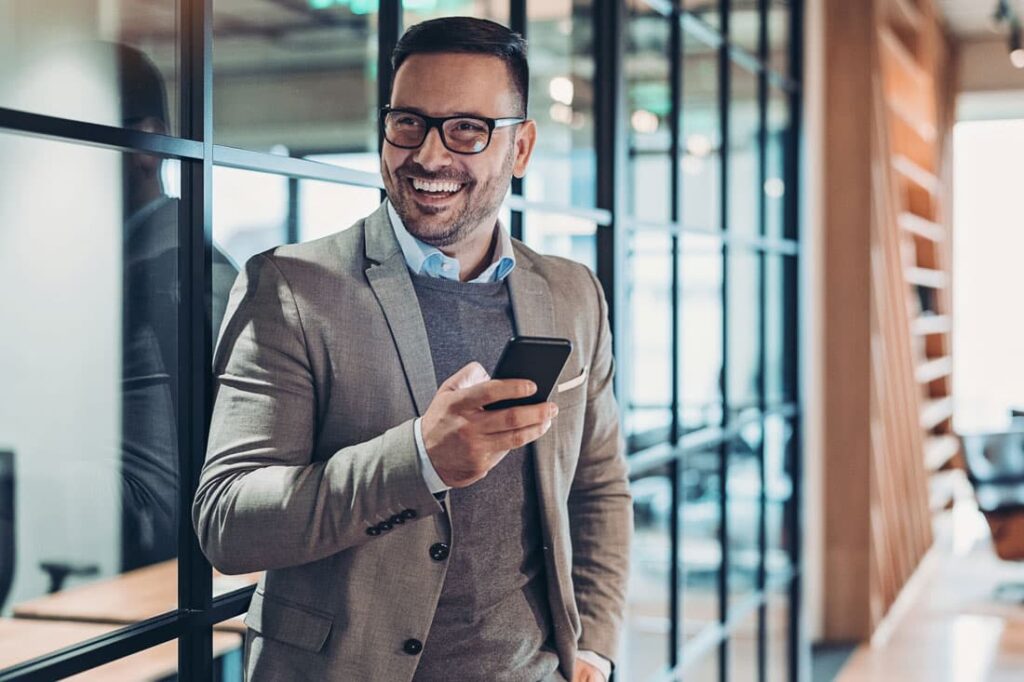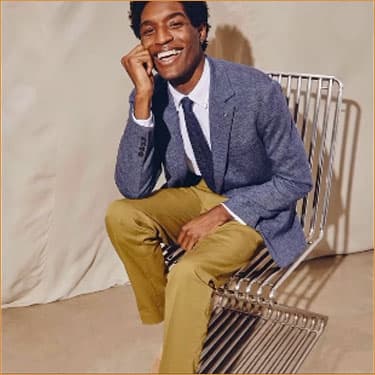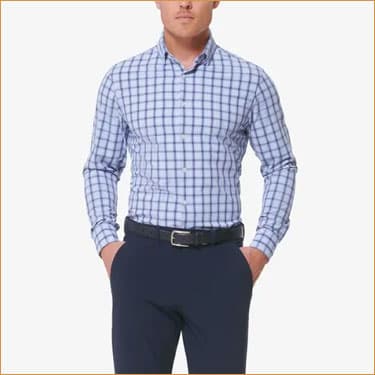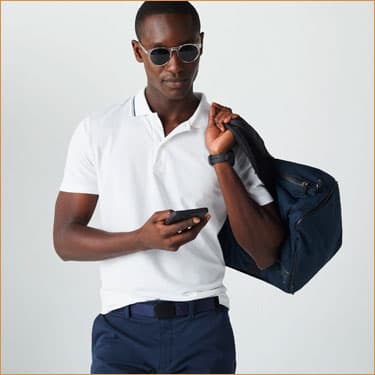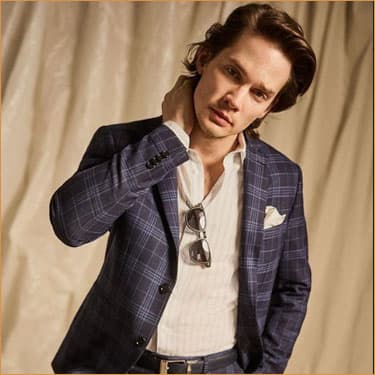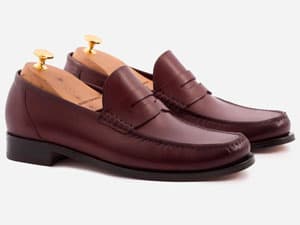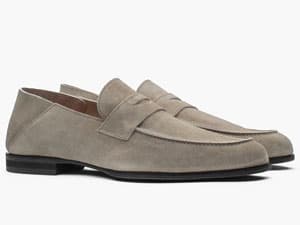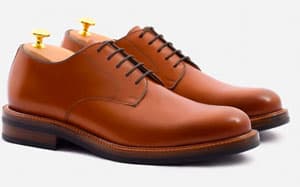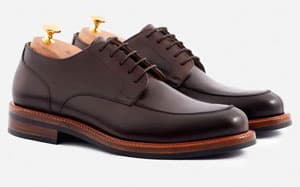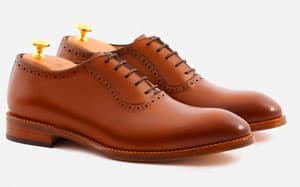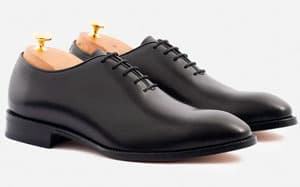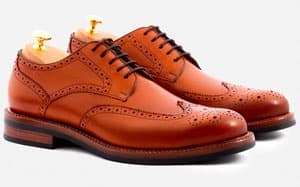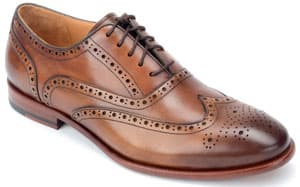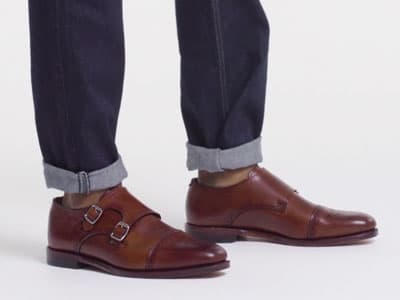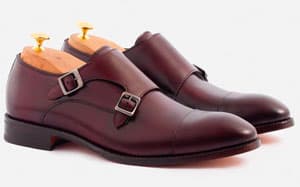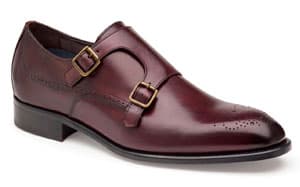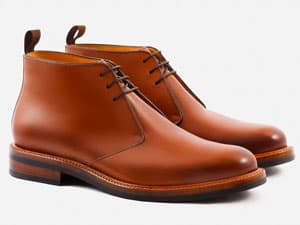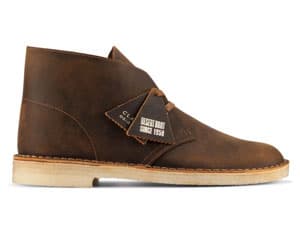A generation ago, dressing for work was easy because damn-near every man with a white-collar job wore a full suit to work.
But in the ever-changing landscape of the 21st century workplace, one thing has become increasingly clear:
The days of formal wear and stuffy suits are (mostly) behind us.

[top image krakenimages; bottom Austin Distel]
Business casual clothing has taken the lead, offering men a more comfortable and stylish approach to dressing for success.
But in the noticeably more casual post-pandemic world we live in (well, hopefully post-pandemic 🤞), figuring out what, exactly, business casual means has become surprisingly tricky.
Different industries seem to define the term differently. In the corporate world, business casual could mean losing the suit jacket and, if you’re really cutting loose, opting for a knit tie on casual Fridays.
But at tech companies it could mean anything from slim fit khaki pants and merino wool sweaters to flip flops and Hawaiian shirts.
To help you navigate the nebulous world of business casual attire, we’ve put together a comprehensive guide that will show you exactly how to dress for success in the 21st century.

The Ultimate Guide to Men’s Business Casual
Everything You Need to Know About Business Casual Attire for Men
First and Foremost:
What is Business Casual for Men?
Business casual is a dress code that falls between traditional business attire like suits, ties, dress pants and dress shoes, and casual wear like polo shirts, a button-down shirt, khakis, jeans and sneakers.
For an individual, the goal of business casual is to strike a perfect balance between professional and comfortable, allowing you to make a polished impression without sacrificing comfort or personality.
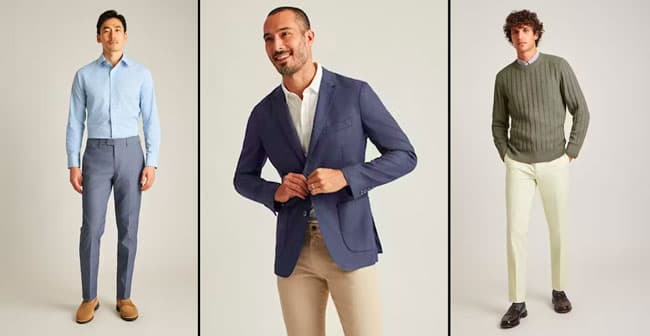
[images: Bonobos]
For a business, the goal of business casual workplace dress codes is to create an atmosphere where employees feel at ease and can focus on their work, rather than being weighed down by formal clothing.
The goal of Business Casual attire is to strike the right balance between professional and comfortable
But as mentioned, the specifics of business casual can vary from one workplace to another. Hell, even the Wikipedia entry for business casual describes it as “an ambiguously defined Western dress code.”
To help you get a better sense of what business asual entails, let’s look at a few key principles that tend to remain consistent across the board.
Dress Shirts are Essential
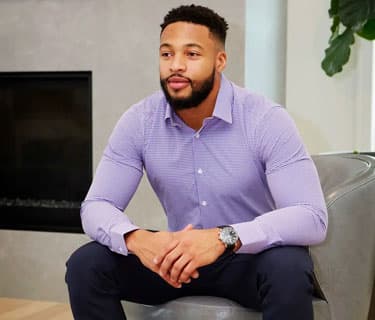
A well-fitted dress button-up shirt is the cornerstone of any business casual outfit.
Opt for long-sleeved shirts in solid colors or subtle patterns, and always make sure they’re wrinkle-free and properly tucked in.
Sharp Shirt Resources:
- The Most Stylish Men’s Dress Shirt Colors
- The Best Non-Iron & Wrinkle-Free Dress Shirts
- The Best Athletic-Fit Dress Shirts
No Need to Tie One On*
*Well, maybe after work with your friends…
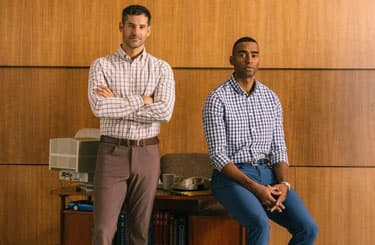
Ties are no longer a necessity for business casual, but they can be a nice addition if you want to elevate your look for an important meeting or presentation.
If you do choose to wear a tie, keep it understated and complementary to your outfit.
Smart Trousers or Chinos
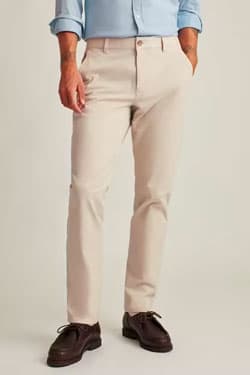
Ditch the jeans and choose trousers or chinos in neutral colors like navy, gray, or khaki.
These versatile pants can be easily dressed up or down, depending on the occasion.
More Great Pants Resources:
Blaze a Trail*
*With your jacket. Please don’t smoke at work.
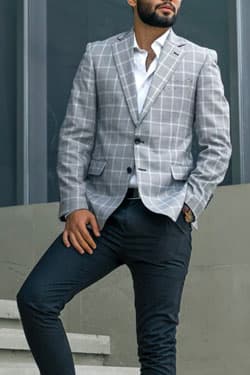
A tailored blazer or sportcoat can instantly transform your outfit from casual to professional.
Choose a well-fitted coat in a neutral color and pair it with your dress shirt and trousers for a polished look.
Dress Shoes, Loafers, or Boots
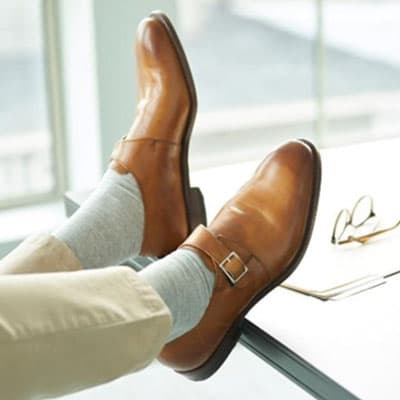
I go into much more detail about business casual footwear below, but for now the most important thing to understand is that your choice of footwear can make or break your business casual ensemble.
Opt for clean, well-maintained dress shoes, loafers, or boots in classic colors like black or brown.
Sharp Shoe Resources:
- The Most Essential Types of Shoes for Men
- The Best Shoes to Wear with Chinos
- Stylish Dress Shoes that Feel Like Comfortable Sneakers
- The Best Oxford Cap Toe Shoes
- The Best Monk Strap Shoes for Men
Accessorize Wisely
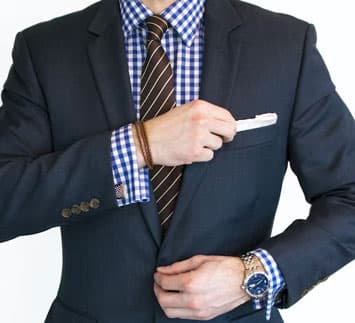
Accessories can be a fun way to express your personal style while maintaining a professional appearance.
Consider adding things like pocket squares, a leather belt, or a good watch to elevate your look.
But remember: with accessories, understatement is key, especially in a business casual setting.
Adding a pocket square or a lapel pin to your blazer can make you look more polished and put together; adding both can make you look like a pick-up arist trying to peacock.
How to Dress Business Casual
Five Go-To Business Casual Outfits
Now that you understand the basic principles of business casual office wear, it’s time to put them into practice.
Here are some specific examples of business casual outfits and get ups that will work well in just about any business casual setting.
Outfit 1:
The Classic Business Casual Look
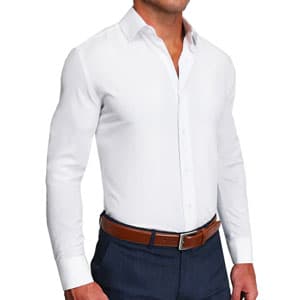
- White or light blue dress shirt
- Navy or charcoal gray trousers
- Brown leather dress shoes
- Brown leather belt
- Optional: Navy blazer and pocket square
This timeless outfit is perfect for everyday wear in the office.
The crisp dress shirt and tailored trousers provide a professional base, while the brown leather shoes and belt add a touch of warmth and sophistication.
If you want to elevate this look for an important meeting, simply add a navy blazer and coordinating pocket square.
Outfit 2:
The Contemporary Business Casual
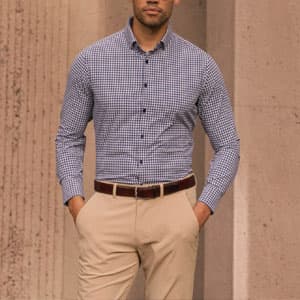
- Patterned dress shirt (e.g., gingham, stripes)
- Khaki chinos
- Leather oxfords, loafers or desert boots
- Leather belt in a color that matches your shoes
- Optional: Unstructured sports coat
For a more contemporary take on business casual, experiment with patterned dress shirts and versatile chinos.
This outfit is perfect for those who want to showcase their personality while still looking professional.
Pair your patterned shirt with khaki chinos for a balanced and stylish look. Complete the outfit with leather loafers or desert boots and a matching belt.
For added flair, consider throwing on an unstructured sports coat to tie the look together.
Outfit 3:
The Casual Friday Ensemble
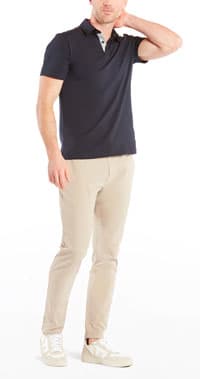
Polo: Go-To Polo
Khakis: Workday Pants 2.0
- Polo shirt or a casual button-down shirt
- Dark denim jeans or casual trousers
- Casual leather shoes or clean white sneakers
- Optional: Lightweight sweater or cardigan
When Friday rolls around, it’s time to embrace a more relaxed approach to business casual.
Swap your dress shirt for a polo or casual button-down shirt and trade your dress pants for dark denim jeans or casual trousers.
Finish the look with casual leather shoes or clean white sneakers for a laid-back yet polished appearance.
If the office is chilly, layer a lightweight sweater or cardigan over your shirt for added warmth and style.
Outfit 4:
The Layered Business Casual
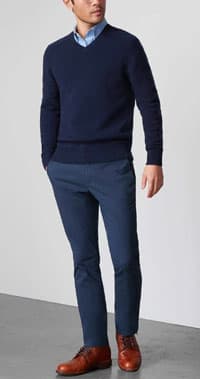
Sweater: Tech Cashmere V-Neck
Collared Shirt: 37.5 Oxford
Pants: Maverick Tech Chnio
- Solid or subtly patterned dress shirt
- Slim-fit trousers in a neutral color
- V-neck sweater or cardigan in a complementary color
- Leather dress shoes or boots
- Optional: Tie and pocket square
Layering is an excellent way to add depth and interest to your business casual wardrobe. Start with a solid or subtly patterned dress shirt and pair it with slim-fit trousers in a neutral color.
Layer a V-neck sweater or cardigan over your shirt for added warmth and sophistication. Complete the look with leather dress shoes or boots, and consider adding a tie and pocket square for a more polished appearance.
Outfit 5:
Summer Business Casual
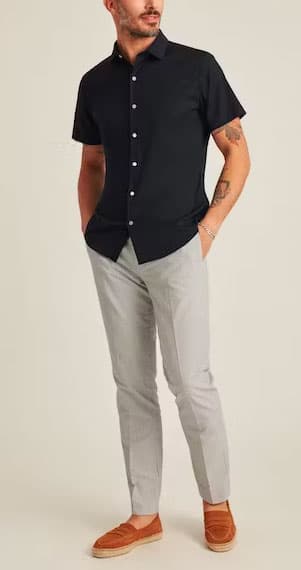
Shirt: Tech Short Sleeve
Pants: Italian Stretch Chinos
- Short-sleeved dress shirt or linen shirt
- Light-colored chinos or tailored shorts
- Suede loafers or clean canvas sneakers
- Optional: Lightweight blazer in a complementary color
When temperatures rise, it’s important to stay cool and comfortable while maintaining a professional appearance.
Opt for a short-sleeved dress shirt or linen shirt in a light color, and pair it with light-colored chinos or tailored shorts.
Complete the look with suede loafers or clean canvas sneakers for a summery take on business casual.
If you need to dress up your outfit for a meeting, simply add a lightweight blazer in a complementary color.
Distinguishing Between Business Casual & Other Attire Styles
One of the things that makes navigating the world of business casual so damn tricky is the fact that there are all sorts of other dress codes that call for similar, but not quite the same clothes.
Let’s take a look at some of the more common (and confusing) types of attire to help you better understand the nuances of all the different styles.
Business Casual vs Business Professional
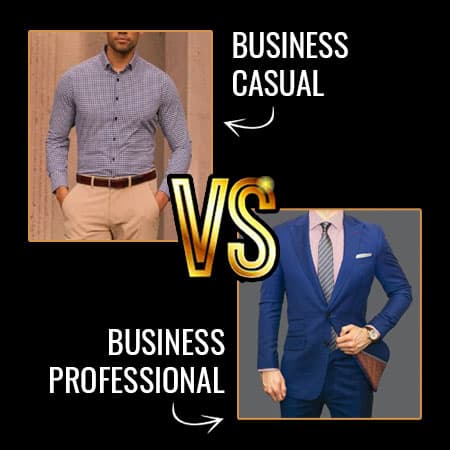
Business casual and business professional are two dress codes that often cause confusion, particularly in the workplace.
While both are designed to present a polished appearance, they differ in terms of formality and the specific clothing items they entail.
Business Casual:
- Dress shirts, but no need for ties
- Trousers or chinos, but not jeans
- Blazers or sports coats, but not mandatory
- Dress shoes, smart casual shoes (e.g. loafers), or boots
As mentioned above, business casual sits right in the sweet spot between comfort and professionalism.
It’s less formal than traditional business attire, with a focus on well-fitted dress shirts, smart trousers or chinos, and optional blazers or sports coats.
Ties are not a requirement, and footwear can range from a smart casual shoe, like a good loafer, to more formal footwear like dress shoes or dress boots.
You can also have a little more fun with the color palette.
Bright colors like neon green may be pushing it a bit too far, but with business casual you can get away with wearing different colors that are a little less conventional, like purple, pink and various pastel shades.
Business Professional:
- Full business suits
- Conservative, solid color suits (e.g., navy blue, charcoal, or black)
- Dress shirts with ties
- Dress shoes (e.g., Oxfords, brogues, or derbies)
- Minimal, tasteful accessories (e.g., cufflinks, tie bars, or pocket squares)
A business professional wardrobe, on the other hand, is more formal, and typically requires traditional suits, dress shirts, and ties.
You can get away with wearing a three-piece suit, but a standard two-button is the safer and more traditional choice.
Suits should come in a dark color and be well-fitted and in conservative colors, while a long-sleeved shirt should be paired with complementary ties.
And speaking of the shirt, the white dress shirt is standard, but you can also get away with other traditional colors like light blue or gray. Louder patterns aren’t appropriate, so leave your floral shirts in the closet.
Oh, and with business professional, make sure you wear a button-up shirt, not a button-down. Button-down shirts are the kind that have small, visible collar buttons keeping the collar pinned in place. They’re considered more casual, and not appropriate for business professional settings.
Footwear should be polished and professional, with classic dress shoes like Oxfords, brogues, or derbies being the standard choices. Accessories should be minimal and tasteful.
A Good Example
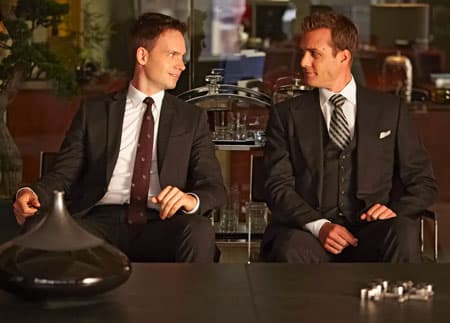
If you want to understand the overall look of business professional office attire, check out the show Suits.
Harvey Specter wears Tom Ford and Ralph Lauren suits, and his colleagues all sport similarly formal looks that perfectly embody the clean-cut appearance expected of a business professional work environment.
(Although it’s worth noting that you don’t need to represent Goldman Sachs to afford a business professional suit. There are plenty of great, affordable suit brands that make well constructed options for a lot less money.)
Smart Casual vs Business Casual
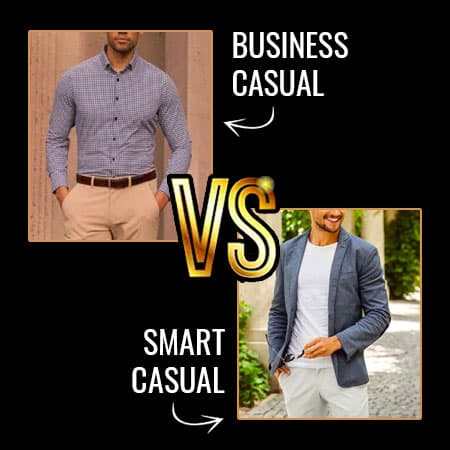
The smart casual dress code is another one that can cause confusion, as it shares some similarities with business casual.
But, while the distinctions might be subtle, there are a few key differences that set them apart.
Smart Casual:
- Collared shirts or high-quality, fashionable t-shirts
- Jeans, trousers or chino pants
- Stylish jackets or blazers
- Sneakers, loafers, or dress shoes
Smart casual is a versatile dress code that allows for more creativity and personal expression than business casual.
While collared shirts are still common, more casual shirts are also acceptable, up to and including high-quality, fashionable t-shirts.
With a smart casual look, jeans can be worn, as long as they’re well-fitted and in good condition.
Jackets or blazers can be used to elevate the look, and footwear can range from clean sneakers to loafers or black or brown dress shoes.
Semi Formal vs Business Casual
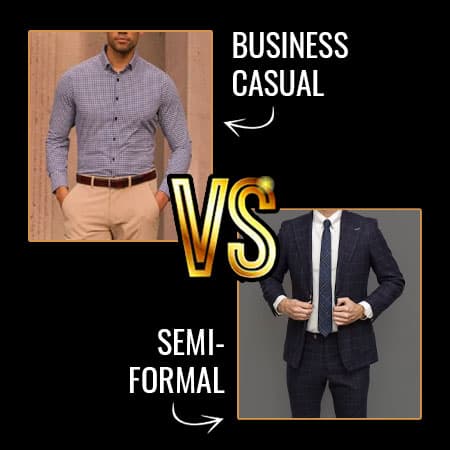
Semi-formal attire is often required for events like weddings, cocktail parties, or other special occasions. While it shares some elements with business casual, it is a distinctly more formal dress code.
Semi-Formal:
- Dark suits (e.g., navy, charcoal, or black)
- Dress shirts with or without ties
- Dress shoes (e.g., Oxfords, brogues, or derbies)
- Optional accessories (e.g., pocket squares, cufflinks, or tie bars)
Semi-formal attire typically requires a dark, well-fitted suit, paired with a dress shirt and dress shoes.
Ties are optional, but can add a touch of sophistication to your ensemble. Accessories like pocket squares, cufflinks, or tie bars can be used to further elevate your look.
Check out our full guide to semi-formal attire for (much) more detail about the ins and outs of this particular look.
Where to Buy Business Casual Clothes for Men
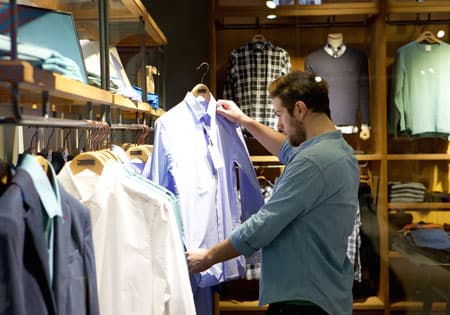
Now that we’ve covered all the basics of business casual for men, we can get to my favorite part: shopping.
Below are a few of my favorite places to shop for new clothes that will satisfy just about any business casual dress code.
Of course, one of the down sides of business casual is that a lot of mall stores like Banana Republic and J.Crew tend to carry similar items in similar styles.
But what I like about each of the outlets below is that they all carry a pretty wide range of styles, sizes, colors and fabrics.
That means you should be able to put together a different look than your cubicle mate or best friend at the office, while still fitting well within the business casual paramaters outlined above.
Bonobos
Mizzen & Main
Mack Weldon
Indochino
State & Liberty
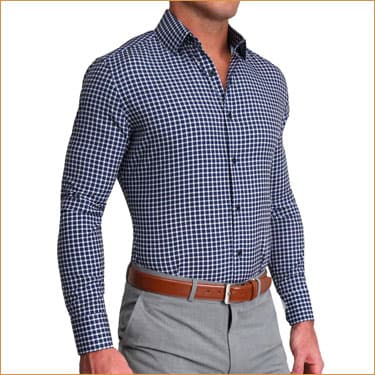
Business Casual Shoes
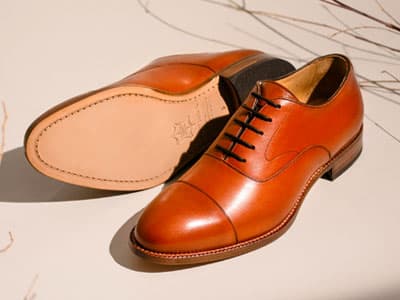
Around here we like to say that shoes are the secret weapon of style, so we’d be remiss if we didn’t take a closer look at the implications that a business casual dress code has on your choice of footwear.
What are business casual shoes?
A business casual shoe is any type of shoe that strikes the balance we talked about, right in the sweet spot between formal and casual. Essentially, a business casual shoe is one that helps you maintain a professional appearance, but isn’t fancy enough for a black tie event.
When choosing business casual shoes, there are a number of different things to consider in order to make the best choice.
For instance, it’s probably a good idea to think about the formality of your workplace, the colors and materials of your clothing, and the overall aesthetic you want to achieve.
In terms of shoe colors, stick to neutral colors like black, dark brown, navy, or dark grey, and make sure your shoes are clean and well-maintained.
Below are some of the most popular business-casual shoes, all of which can work well in most business casual settings.
Loafers
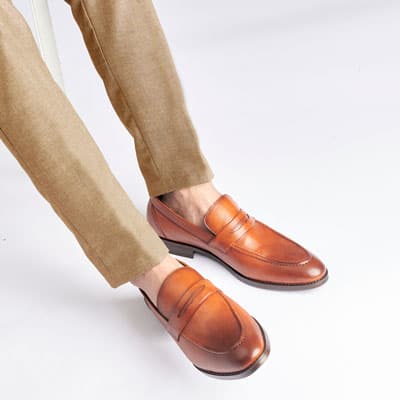
Loafers are slip-on shoes without laces, and often feature a low heel and a moccasin-style top.
They can be made of leather, suede, or other materials and come in a variety of sub-styles, including tassel loafers, horsebit, penny loafers and more.
Sharp Selections:
Derby Shoes
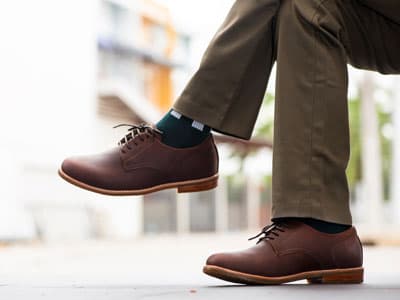
Also known as bluchers, these lace-up shoes have open lacing, which means the quarters (sides of the shoe) are sewn on top of the vamp (front part of the shoe). They are less formal than oxford shoes but still look polished.
Sharp Selections:
Oxfords
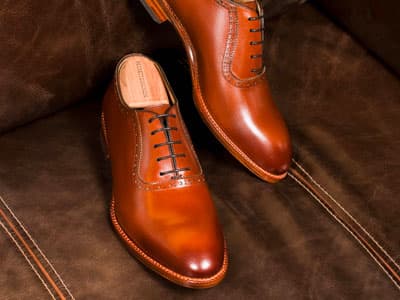
Classic lace-up shoes with closed lacing, meaning the quarters are sewn under the vamp.
Although oxfords can be more formal, less embellished designs in brown or suede can work as business casual shoes.
Cap-toe oxfords also make a great choice for business casual, because the capped toe box gives the otherwise quite-dressy shoe a slightly more rugged, workman-like vibe.
Sharp Selections:
Brogues
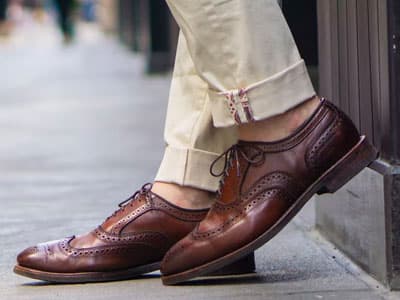
Shoes featuring decorative perforations (broguing) on the leather. They can be oxford or derby style, and the level of formality depends on the amount and intricacy of the broguing.
Sharp Selections:
Monk Strap Shoes
As their name implies, monk straps are enclosed with a leather strap that’s sealed by a buckle, instead of traditional laces.
Single or double monk straps can work well for business casual attire.
Sharp Selections:
Ankle Boots
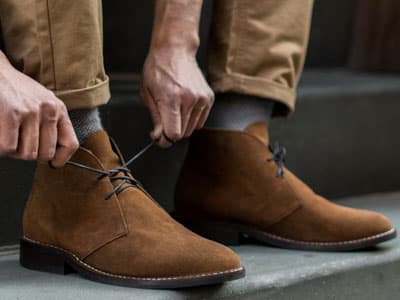
Leather or suede boots that cover the ankle can be appropriate for business casual settings, especially Chukka or desert boots with a minimal design.
And if you really want to make a good impression, choose boots that have a svelte toe shape similar to what you’d find on a pair of dress shoes.
The sharper toe shape will make the boots look a little more sophisticated, which makes them more appropriate for pairing with dress slacks or a crisp dress shirt with long sleeves.
Sharp Selections:
Business Casual Shoes FAQ
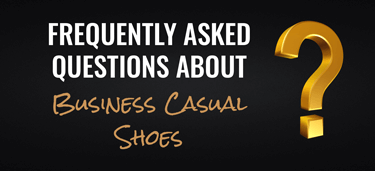
The styles mentioned above should give you a basis for understanding what counts as a business casual shoe, but here are a few more specific questions that can help fill in any remaining gaps.
Are sneakers business casual?
Sneakers are generally not considered business casual. With that said, some workplaces may accept clean, minimalistic, and well-maintained sneakers in neutral colors. Again, it’s always smart to assess your workplace’s dress code and culture before wearing sneakers in a business casual setting.
Are sandals business casual?
Sandals are typically not considered business casual. They expose too much of the foot, which means they lack the formality usually required for a professional setting. But closed-toe or dressier sandals may be acceptable in more relaxed workplaces.
Are boots business casual?
As mentioned above, boots can definitely be business casual, especially ankle-length boots like Chukka or desert boots made from leather or suede that have a minimalist design and a sharp toe shape.
Are loafers business casual?
Definitely. Loafers are a popular choice for business casual footwear because they’re both comfortable and stylish, which falls right in the sweet spot. Your best bet is to opt for leather or suede loafers with minimal embellishments.
Are tennis shoes business casual?
Tennis shoes and other athletic shoes like runners or basketball shoes are not considered business casual because they lack the formality usually expected in the workplace. That said, some laid back offices (think a West Coast tech start up) might allow them, but it’s not standard.
Are Chelsea boots business casual?
Some Chelsea boots can be business casual, but only if they’re sleekly designed, fairly minimalist and well polished. A muddy pair of lug-soled Blundstones probably wouldn’t cut it, but a sleek pair of Amberjacks definitely would.
More Resources ↓
More Men’s Suits and Style Advice Irreverent Gent:
- Everything You Need to Know About Semi-Formal Attire
- How to Buy Your First Suit
- The Ultimate Guide to Rocking the Blue Suit and Brown Shoes Combo
- How to Dress Better for Guys
- What to Wear to a Funeral: The Complete Guide to Proper Funeral Attire
- How Should a Suit Fit? The Definitive Guide
- The Best Wrinkle-Free & Non-Iron Dress Shirts
- The Best Affordable Sunglasses Brands
- The (Absolute) Best Trimmers for Shaving Your Balls
- The 19 Most Stylish Pieces of Men’s Winter Fashion
- The Most Stylish, Stretchy & Comfortable Suits for Men
- The Best Suit Brands for Men of Every Shape, Size & Budget
- The Best Places to Buy Cheap Suits Online
